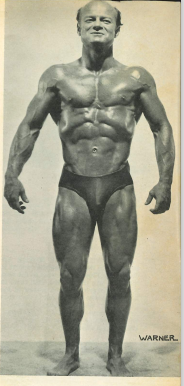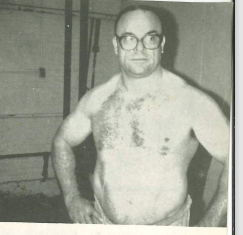I have been surprised at the many letters, telephone calls, and face to face inquiries I have received since the results of my composition test were reported in the November, 1977, issue of Iron Man. The average, normal fat content for my age group (39 at the time) is 15.7%. Test performed at Lovelace Bataan Medical Center in Albuquerque, New Mexico, using the water submission method, showed my body fat level to be 2.4%.
To put my test result in further perspective, a fat level in excess of 20% is considered obese, and under 10% is considered good for an athlete. I am told that Bruce Jenner, the Olympic decathlon champion, proudly announced on a nationally televised talk show that his body fat level had been measured at 8%. So many people have asked me what methods I used to become so lean, that I thought readers would be interested in my answer.
Wheaties may be Bruce Jenner's secret but it certainly is not mine. In fact the method I use is so simple it probably should not be considered a secret at all. If there is a secret to successful long term weight control it is DIET WITHOUT PSYCHOLOGICAL DEPRIVATION.
Before I explain what I mean by diet without psychological deprivation, I should first interject that exercise is required to achieve lean body mass. Iron Man readers do not need to be convinced that progressive resistance exercise is the best way to build muscle and that it is not the purpose of this article. I do, however, want to make it clear that unless you want to look like a concentration camp victim, you cannot achieve an extreme degree of leanness without combining exercise and diet.
In the minds of most people, the term "diet" itself is synonymous with hunger and deprivation. I have found that this need not be so. I can honestly say that I reduced my bodyfat level below 3% without hunger, and without feeling deprived in any way. If you do feel hungry and deprived on the diet that you are following, the odds are that you will not be successful in maintaining a lean body. The eating habits that I advocate can easily be followed for a lifetime. The conventional low calorie diet, or the low carbohydrate diet work, but except for a few exceptionally determined people, these crash diets do not work on a long term basis.
The diet that I followed before my first body composition test and which I advocate has two critical characteristics. First, it is filling and satisfying, and secondly, it is low in calories. You will see, however, that it is not a typical low calorie diet that your family doctor might prescribe. I do not believe it is sound advice to simply say, "Eat everything you want but just eat a little less than you are now and you will lose weight." By following that advice you will lose weight, but I believe that for most people that is not the best approach for maintaining a healthy lean body over a lifetime.
My cardinal rule to AVOID CONCENTRATED CALORIES. To give a simple example, sugar contains more calories in one of the most concentrated forms possible. On the other hand an apple has a lot of volume with few calories. It has a low concentration of calories. Eat all of the sugar or all of the sugar filled foods you want and you will take in more calories than your body can use and you will become fat. By contrast, eat all the apples you want, or even gorge yourself on apples and you will not take in more calories than your body can use and you will not become fat. Butter is another example of a concentrated calorie food. You can eat your fill of baked potatoes and not get fat. But if you drench the baked potato in butter and eat all you want you will get fat.
Another characteristic of the concentrated calorie foods is that they stimulate the appetite and encourage you to overeat. You will eat more baked potatoes if you add butter and you will eat more candy coated apples than you will apples alone. The food processors know exactly what they are doing when they add sugar to almost all processed foods. The more sugar they add, the more you eat and the more their cash registers jingle, and of course, the fatter you get. If you stick to the natural foods like the potato and the apple you will not overeat, you will not get fat, and best of all you will be comfortably full and satisfied.
I am not suggesting that you live on apples and potatoes. I simply use these two excellent foods as examples of natural foods that taste good, fill you up, make you feel satisfied, and still do not overload your body with calories and make you fat.
To further illustrate the method of eating I advocate, let me conclude by telling you what I ate during a typical day leading up to the body composition test that has aroused so much interest.
For breakfast I ate a cereal I made myself with the following ingredients: rolled oats, bran, wheat germ, sunflower seeds, fresh fruit for sweetening topped with Grade A raw whole milk. This cereal is nourishing, filling, it tastes good, and it is low in calories because it contains none of the concentrated calorie foods.
Lunch was more of a problem because I had to take it with me to the office, but I still avoided the concentrated calorie foods. I usually had a peanut butter sandwich with whole raw milk or yogurt and an apple or baked potato. You may be thinking, "Who is he trying to kid by telling us that peanut butter is not a concentrated calorie food?" You would be correct if you went to the supermarket and grabbed a jar of peanut butter from their shelves. Most supermarket peanut butter is like any other processed food, it is filled with sugar. The peanut butter that I use is made by my wife, Carol, using nothing but peanuts she roasts and blends herself. It contains no sugar and salt. The bread is whole grain which I secure from a health food store. It would be better still to make the bread yourself at home so that you could completely control the ingredients. I have found that even the whole grain bread that is sold in health food stores contains honey or other concentrated calories that I would prefer to avoid.
My evening meal was usually a salad made with assorted greens, fresh vegetables, eggs, and nuts. By using your imagination you can create a delicious, huge, nourishing and filling salad, but which is still low in calories. The danger here is the dressing you may be tempted to put on the salad. Dressing is just like the candy on the apple or the butter on the potato. It adds more calories and tends to make you eat more than you would ordinarily need to feel full and satisfied. I think you will be surprised to find that a salad of this type tastes delicious with no dressing at all. If you fell you have to have some dressing, try lemon juice or vinegar along, and if you must, go ahead and add oil, but keep it to a minimum.
If I was hungry later in the evening I would have a snack of fresh fruit, usually apples or pears. I eat everything but the stem, and I ate all I wanted because as I said earlier, you can literally gorge on this type of food and not become fat. I, however, found that I was usually satisfied with one or two apples or pears.
If you make a lifetime habit to eat only natural unprocessed foods, you will avoid almost all of the concentrated calorie foods. You will never be overweight and you will never feel hungry or deprived. For those who wish to further explore this method of eating, I strongly recommend that you read the book, Did You Ever See A Fat Squirrel? by Ruth Adams.
Enjoy Your Lifting!












